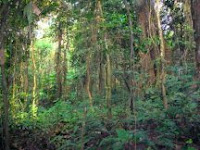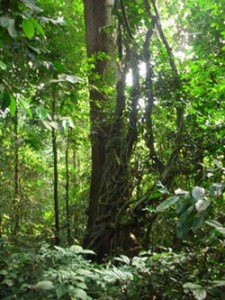Cultural critics Jeremy Gilbert and Ewan Pearson point out that music can be understood either as possessing or producing meanings, or as producing effects which cannot be explained in terms of meaning — that “music can affect us in ways that are not dependent on understanding something, or manipulating verbal concepts, or being able to represent accurately those experiences through language.” Music thus has a metaphysical dimension; where music affects the body, the distinction between outside — where the music comes from — and inside — where the music is felt — is radically called into question. Musicologist John Shepherd therefore describes music as a site of exchange, a shifting boundary between the outer and the inner.
 |
Sound thus differs from vision. The eye and its gaze have long been the primary trope of European thought — what cultural theorist Luce Irigaray calls “the predominance of the visual, and of the discrimination and individualization of form.” This discourse privileges the visual as the purest and most important form of sense experience. Thus, vision encourages projection into the world, occupation and control of the source of experience; whereas sound “encourages a sense of the world as received, as being revelatory rather than incarnate.”
But the visual is a relatively less important part of the cognitive set of the jungle dweller. When I studied jungle survival with mestizo instructor Gerineldo Moises Chavez, I was struck by how little emphasis he placed on animal tracking; instead, the mestizos have a great ability to recognize and imitate the sounds of the animals, along with an intimate knowledge of their habits and likely locations. On one level, of course, mestizos do not emphasize tracking when they hunt because the thin jungle soil simply does not take tracks well, and rain regularly washes away both tracks and sign in any event. But there may be more. Two anthropologists — Peter Gow, speaking of Western Amazonia, and Alfred Gell, speaking of New Guinea — emphasize the spatial boundedness of rainforest life. As Gow puts it,
It is hard to see Amazonia as landscape, in the sense this term has for people from temperate climes. The land does not recede away from a point of observation to a distant horizon, for everywhere vegetation occludes the view. In the forest, sight penetrates only a short distance into the mass of trees. Along the big rivers, you can see further, but even here there is no distant blue horizon. The sky starts abruptly from behind the screen of forest.
To travel in the jungle, Gow says, “is to pass through an endless succession of small enclosed spaces.” Gell speaks the same way of New Guinea. “I spent fourteen months,” he writes, “in visual surroundings limited to tens of metres … To this day, I do not know what Umeda village looks like from a distance.” Gell proposes that such a primary forest environment imposes an organization of sensibility that emphasizes both hearing and smell over vision.
 |
Thus, hunting in dense forest “places a premium on hearing as the main sensory modality for detecting objects and events at a distance, where they are invariably out of sight.” Gell also notes the large class of vocal “sound effects” with which the Umeda punctuate and illustrate their stories — a phenomenon I had noted among the mestizos, and had puzzled over, until I had read Gell’s article. Thus, the mestizo shaman inhabits a sound world in which sound itself is meaningful and powerful beyond words.
And thus the icaro — sung, whispered, whistled, breathed softly — and the rustling sound of the shacapa, the leaf-bundle rattle.

- Previous Post: Eliade’s Shamanism
- Next Post: Burundanga
- More Articles Related to: Indigenous Culture, Shamanism, The Amazon


